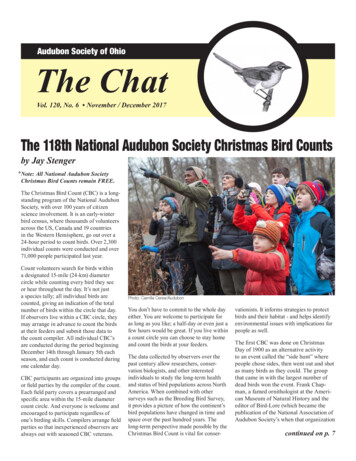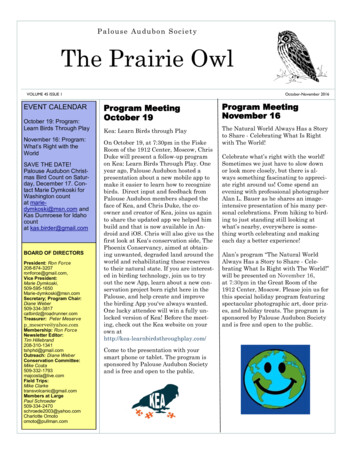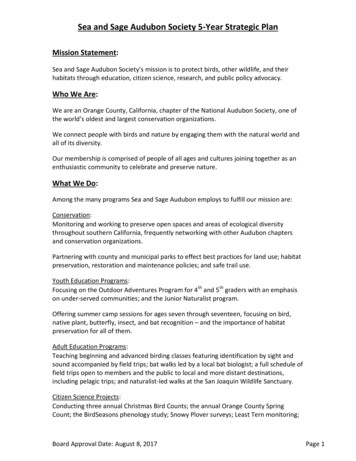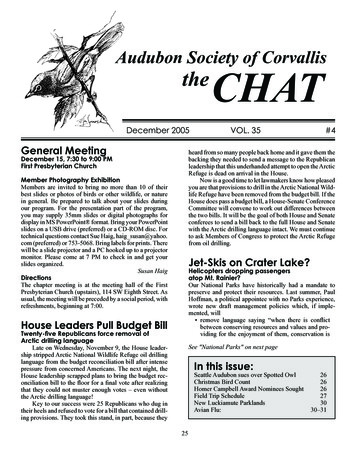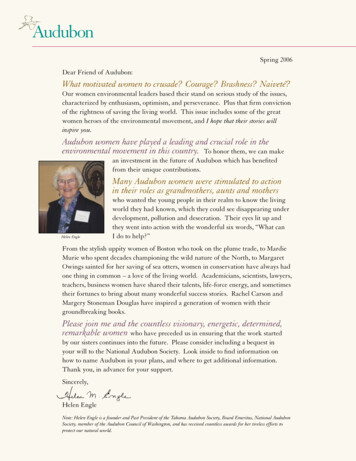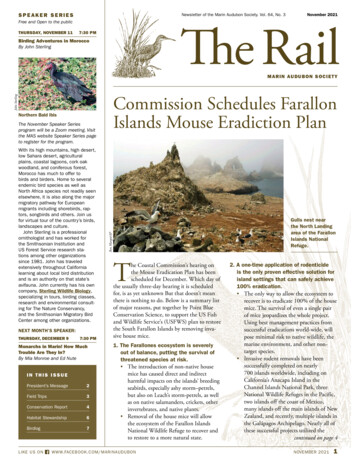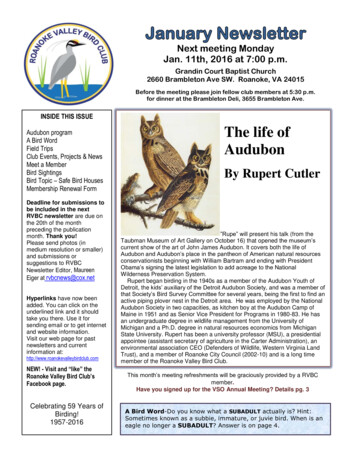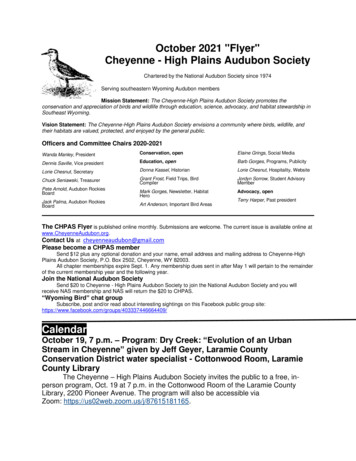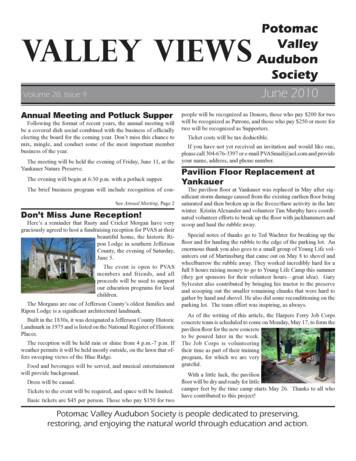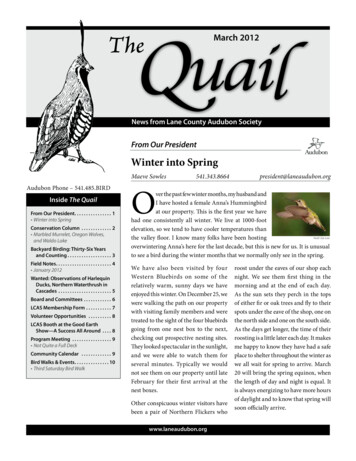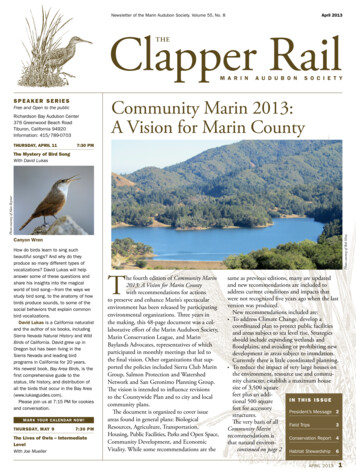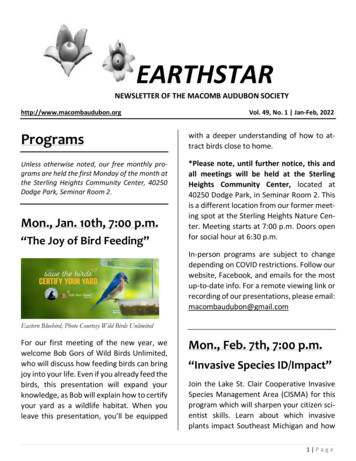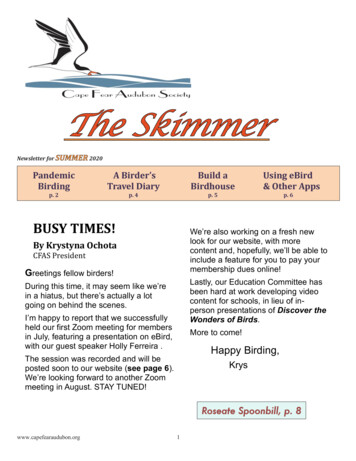
Transcription
Newsletter for2020PandemicBirdingA Birder’sTravel DiaryBuild aBirdhousep. 2p. 4p. 5BUSY TIMES!Using eBird& Other Appsp. 6We’re also working on a fresh newlook for our website, with morecontent and, hopefully, we’ll be able toinclude a feature for you to pay yourmembership dues online!By Krystyna OchotaCFAS PresidentGreetings fellow birders!Lastly, our Education Committee hasbeen hard at work developing videocontent for schools, in lieu of inperson presentations of Discover theWonders of Birds.During this time, it may seem like we’rein a hiatus, but there’s actually a lotgoing on behind the scenes.I’m happy to report that we successfullyheld our first Zoom meeting for membersin July, featuring a presentation on eBird,with our guest speaker Holly Ferreira .More to come!Happy Birding,The session was recorded and will beposted soon to our website (see page 6).We’re looking forward to another Zoommeeting in August. STAY TUNED!KrysRoseate Spoonbill, p. 8www.capefearaudubon.org1
First, a word of caution The COVID SummertimeBirding BluesDue to a mild winter/spring climate, manycreatures have taken advantage to produce youngearly and in abundance — talking about SNAKEShere. We “warbler-necked” wanderers often don’twatch where we step. Please do, my friends.By Gretchen SchrammI know. I know Having our multitude of scheduled CFAS birdwalks all of a sudden cancelled due to COVID-19has been hard on yours-truly, as well as on eachof the volunteers who’ve offered to lead walks. It’sbeen more than disappointing to lose the time andeffort it took to organize and put these events inplace, especially since it will be my last yearcoordinating the outings. I had wanted to makethis one more than special.I have seen more snakes in the past three monthsthan I have in the 10 years I’ve lived in Wilmington.Although most of our snakes are non-venomous,three local dangerous ones come to mind:copperheads, cottonmouths (AKA watermoccasins), and rattlers. Just last week Iencountered a copperhead in the road next to mydriveway, recognizable by its distinctive markings.G. SchrammThis one’s bright yellow tail identified it as ayoungster. Usually, copperheads are born in latesummer and early fall, but this year they wereearly. Watch where you step!Though the copperhead’s bite is less potent thanthat of our other venomous snakes, it strikes morepeople than any other. Stepping on one can ruinyour day.B. RoushPre-pandemic birding bliss. A Holly Shelterouting spring of 2018.Suspending these trips has been a painful call, butI just could not envision a safe way for us to birdas a group. We are always pointing to a featheredfriend over someone’s shoulder, sharing binocs,clustering into a tight core to avoid a bird being‘surrounded’ — but it’s all just too risky now. So,no wavering: protecting health and life wins outover any enjoyable outing.That being said (with a sigh), here are somethoughts on how you CAN make this year ofbirding just as rewarding.www.capefearaudubon.orgG. SchrammThis beautiful, beneficial RAT SNAKE is nonvenomous.On to the GOOD NEWS, page 32
Now, the GOOD News:The birds are still out there. They seemtotally unaware of COVID-19. I’ve seenlots of them, and not just in my owngarden.If you preferto bird athome Eastern KingbirdThere arebirders’ websitesthat can adddimensions toyour experience.My dear friendand fellow CFASmember SherryLane directedme to theG SchrammBirdTheFeckAtHome Facebook page. It is wonderful!Originating in Australia, this marvelous site nowwelcomes birders from all over the world, united by thepandemic. Their posted reports include ONLY birdsrecently seen in gardens. As of this writing, well over3,600 species have been reported, with 81 countriesparticipating.G SchrammKilldeerIf you choose to venture out, you canalways wear a mask, stay distanced, and besensible.The site has easy-to-follow instructions for signup andparticipation, beautiful photographs, amusing spin-off“threads” that venture into animals, funny bird pictures,anecdotes, and a warm sense of the worldwide birdingcommunity coming together in these stressful times. Ihighly recommend joining up as another way to enjoybirding while stuck at home. Here’s the link:There are many parks and open spaces in andaround Wilmington where you can bird withoutrisking virus exposure, especially if you go early r late), when crowds are not inclined to gather.Great-crestedFlycatcherG SchrammRed-bellied WoodpeckerG Schrammwww.capefearaudubon.org3
Ranging Out:Following the walking tour, flightdemonstrations wereheld with free-flightowls, falcons, kites andhawks. The birds werereleased over 200 yardsfrom the trainers andflew toward usuntethered. Watchingthese birds of prey fly toward their trainers wasmost impressive. We were told it takes severalmonths to train the birds, and they wouldrespond to only one trainer.Raptors:A Road TripStory and photos by Jack ManockCFAS Board MemberIn March, my wife, Nancy, and I visited theCenter for Birds of Prey, located 29 milesfrom Charleston, South Carolina, on Route 17North. As we left 17 and traveled down awinding dirt road, the movie “Deliverance”came to mind. After approximately two mileswe came to an opening where there were cagesfor nearly 50 species, including eagles, hawks,falcons, kites, vultures and owls. This is one ofthe largest and most diverse collections of itstype in the United States.We did not visit the Avian Medical Clinic,another component of the Center. The clinicaverages 800 patients a year, representing avariety of birds of prey and shorebird specieswith injuries ranging from unknown to critical.The clinic relies on a network of trainedvolunteers located throughout South Carolinato help treat ill or injured.The admission was 18 per person, and wellworth it. The demonstrations and tour wereexceptional, and I expect we will return for oneof their photography workshops.I recommend a visit to all our Audubonmembers. For details on the center’s activitiesand special programs, check out their e arrived in time for the 2 p.m. guided tour.On Thursdays, Fridays, and Saturdaysthroughout the year, the Center provides toursto visitors at 10 and 2. For the first hour wewere guided on a walking tour by anenthusiastic staff member who shared storiesabout individual birds, including a femaleeagle protecting unfertilized eggs, a 44-yearold vulture who would not allow another birdin his cage, and a young owl who hadimprinted on a person when he opened hiseyes the first time — when it came time tomate he refused to accept that he was an owl.www.capefearaudubon.org4
Birdhouses can be purchased in many gardencenters, bird stores, or large home-goods stores,but they can also be built at home. They can be assimple or complicated as you would like.Many websites offer help for birdhouse builders.Cornell Lab of Ornithology has one entitled “Learnabout Nest Boxes and Nest Structures,” withadvice on how to attract the “Right Bird, RightHouse,” the types of birds likely to nest in yourregion, and even downloadable plans. They alsolist which species are in decline and may benefitfrom added birdhouses or nest sites.Regina PodolskisCFAS Treasurer & Membership ChairAre you a birder, a wanna-be birder, or someonewho simply enjoys watching birds? Do you carewhat type of bird frequents your backyard or doyou just marvel at their colors, shapes, andhabits? Adding feeders, bird baths, birdhouses ornest structures can be a wonderful way to attractbirds while helping to promote their numbers andlongevity.Once youdetermine theregional birds youwould like toattract, the nextdecision is the sizeof the entranceCourtesy: SunCatcherhole. Its diameterdetermines the types of birds who will fit into thebirdhouse. But a hole too big deters smaller birds,since it puts them at risk from predators.Suggested diameters range from 1.5 to 6 inches.My husband and I are among those who simplyenjoy watching birds and listening to their songsand chatter. We had received a gift of abirdhouse made from a gourd, and afterresearching the best place to mount it, we werethrilled to see birds surveying the new birdhouseand then building a nest there. We decided aworthwhile pandemic project would be to buildand mount yet another birdhouse. Thus theresearch began.Other important decisions include the height of theentrance hole, where to mount the birdhouse, andwhat to attach it to. With the exception of purplemartins and bluebirds, most birds preferbirdhouses in a concealed area that addscamouflage and provides a branch or two so theparents can land near their young.Various birdhouse designs cater to different birdsbeyond those you see at your feeders or gardenflowers, so adding one can increase the diversityof your backyard visitors.Birdhouses attractbirds that buildnests, lay eggsand raise theiryoung insideshelteredchambers orcavities. Thesespecies arereferred to ascavity-nesters.Our local cavitynesting birdsincludeCourtesy: SunCatcherchickadees,wrens, bluebirds, and nuthatches. To feed theiryoung these birds need easy access to insects,caterpillars and spiders. We can attract them byoffering suitable nesting sites.www.capefearaudubon.orgA little research will lead you to many helpful sites.Examples include Cornell Lab’s, mentionedearlier https://nestwatch.org/learn/all-about-birdhouses/ and the SunCatcher Studio, where you canfind general information, details, and plans forbuilding your househole-size/Remember, nesting birds will still need nestingmaterials, food for their chicks, and water fordrinking and bathing. But building a birdhouse canbe rewarding for adults and children alike.Watching a bird build its nest inside the birdhouseand then hearing and watching it raise its familycan delight the whole family.5
By all accounts, our first attempt at presenting an ONLINE public programwas a huge success. The July 6 inaugural event, with guest presenter HollyFerreira, came off without a hitch.After three-month shutdown due to coronavirus closures, our chapter’s first-Monday publicprograms are back. But instead of meeting at a physical location (traditionally Halyburton Park),we’re now together on Zoom, the online video conferencing platform.Holly Ferreira, conservation biologist at Marine BaseCamp LeJeune, came well qualified to guide us through“How to use eBird and Other Birding Apps.” eBird isa free app, an online database of bird observationsproviding scientists, researchers and amateur naturalistswith real-time data about bird distribution and abundance.It is a joint project of the Cornell Lab of Ornithology andAudubon.Ferreira, obviously comfortable with the technology ofonline discussions, walked us through eBird’s manydimensions and capabilities, explaining the variety ofways users can interact with — and add to — its massiveand growing database. She finished with overviews ofother apps, such as Merlin, Sibley, and Audubon.Using a text-chat option, our audience of birders submitted their own questions and observations throughoutthe session. Most of these were addressed in opendiscussion near the end.FerreiraNancy Buckingham, inveterate organizer of CFAS public programs, says she is delighted with thesuccess of this one, and hopes to announce another in the near future. Lindsay Addison handledthe Zoom session’s setup and its many nuts and bolts. She reports that 74 people had preregistered for the session.And of course we all look forward to convening again in person at Halyburton Event Center.WATCH A RECORDING OF THE PROGRAM! Go to:https://audubon.zoom.us/rec/share/ 6 J2KUt1vOIrZUse this Password: 3D&F@?5@www.capefearaudubon.org6
At Your ServiceUsing Safe,No-contactCurbsideServiceSubmitted by Charley WinterbauerWant to Donate?- Michelle FrazierKeeping the health of the community and the welfare ofour local birds in mind, both Wild Bird and Gardenlocations offer a convenient schedule of curbsideservice. All of our favorite bird-friendly supplies,optics, and nature-lover gifts are available and, if youprefer to wait for the return of joyful browsing, you canstill support the store now with the purchase of giftcertificates in any amount.Here’s how curbside works: Simply call ahead andplace your order. The staff will get it ready and willmeet you out front with your items. Or walk upcurbside and staff can show and talk with you aboutspecific items at a safe distance.CFAS has teamed up with students fromUNCW to inspire disadvantaged urbankids to pursue birdwatching.Southport Schedule:Monday, Friday, Saturday 10:00 - 2:00For Southport service call:910 457-9453An important step is to gather thenecessary birding equipment.Binoculars, mainly.If any of you members (or others) haveextra usable binoculars to donate for thisendeavor, don’t hesitate to contact Evan Buckland,elb9021@uncw.eduWilmington Schedule:Monday through Saturday 10:00 – 4:00 (EXPANDED)For Wilmington service call:910 343-6001The stores will be following the guidance of publichealth and government officials and we hope toeventually expand scheduling accordingly, so keep aneye on the website for news.www.wildbirdgardeninc.comor Marae te: Cape Fear Audubon partners frequently with Wild Bird andGarden in efforts that promote birds, bird survival, and birding. Weare pleased to see them back in operation in support of birds duringcoronivirus restrictions. CFAS7
SightingsBy Nancy BuckinghamThe rare appearance of a Roseate Spoonbill forseveral weeks in June along our neighborhood's tidalcreek brought a lot of new interest in birds for ourneighbors young and old.Several neighbors posted photos of the bird on ourneighborhood Facebook page and one of the childrenhad named our special visitor "SpoonerPinkerton" because of all the pink in Spoonbills.Photo: Sam CooperIn MemoriamJOHN BERNARD ENNISDecember 28, 1945 - July 3, 2020John’s passing, on July 3, will be mourned by the many Cape Fear Audubon Societymembers who knew him.John was a fixture at our CFASmonthly meetings and frequentlyparticipated in the bird walks; hisexperience and knowledge of thenatural world were always aninspiration to those around him. Hecontributed enormously.A wildlife photographer and naturalist,member of Carolina Bird Club andCFAS, John had 30 years ofexperience in birding andphotographing nature. His trips tookhim to 49 states in North America, aswell as to Canada and Mexico.John recently donated his lifetime of birding and nature books to CFAS, who in turnfound a permanent residence for them at UNCW.John’s obituary can be accessed rnard-ennis/If you would like to leave a message for his family, or just express your condolences,it would be a kind thing to do for such a kind man.www.capefearaudubon.org8
Follow us onFACEBOOKMissippi kite. (Photo by Gretchen Schramm). Moreof them have been seen in our area over the past few years.The Skimmer is the quarterly newsletter of the Cape Fear Audubon Society(CFAS), a regional chapter of the National Audubon Society.The MISSION of the Cape Fear Audubon Society is to conserve and restorenatural ecosystems within our region, focusing on birds and other wildlife for thebenefit of humanity and the earth’s diversity.President: Krystyna OchotaVice President: Jim NesbitSecretary: Morgan FreeseTreasurer: Regina PodolskisWorking Committees:*Board Members (& Committees):Lindsay Addison (2)Nancy Buckingham (1, 6)Dan Essigmann (1)Morgan FreeseGene HugueletJack ManockCatherine Nesbit (3)Jim Nesbit (2)Regina Podolskis (5)Robert Roush (1)Sara Meissner, PresidentUNCW Seahawks Chapter1 - Communications2 - Conservation3 - Education4 - Field Trips5 - Membership6.- Program PlanningWebmaster: Dan EssigmannSkimmer Editor: Robert RoushInterested in serving on our board, or one of our working committees? We're currentlyin need of a new Field Trip Coordinator. Contact us to find out how you can MAKE A DIFFERENCE FOR BIRDS!WEBSITE: .org9
Many websites offer help for birdhouse builders. Cornell Lab of Ornithology has one entitled “Learn about Nest Boxes and Nest Structures,” with advice on how to attract the “Right Bird, Right House,” the types of birds likely to nest in your region, and even downloadable plans. Th
